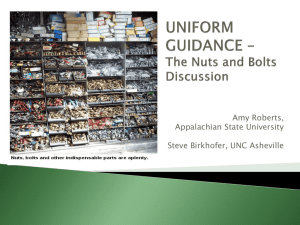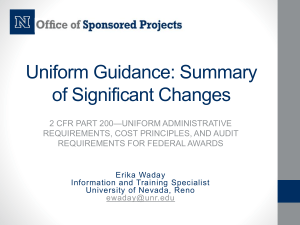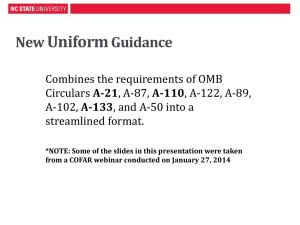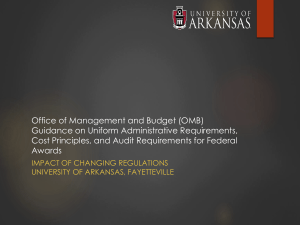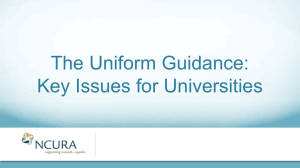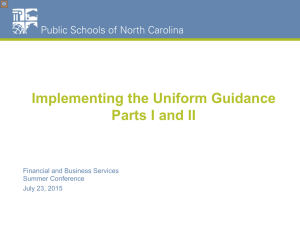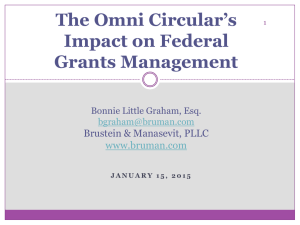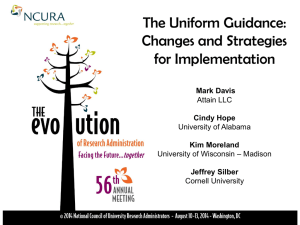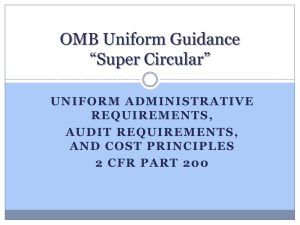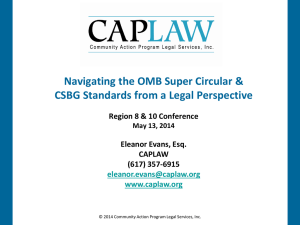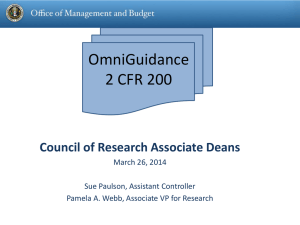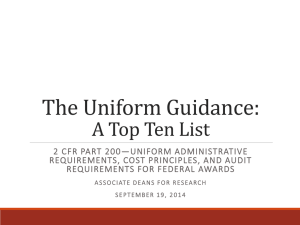UG Presentation - University of Missouri
advertisement
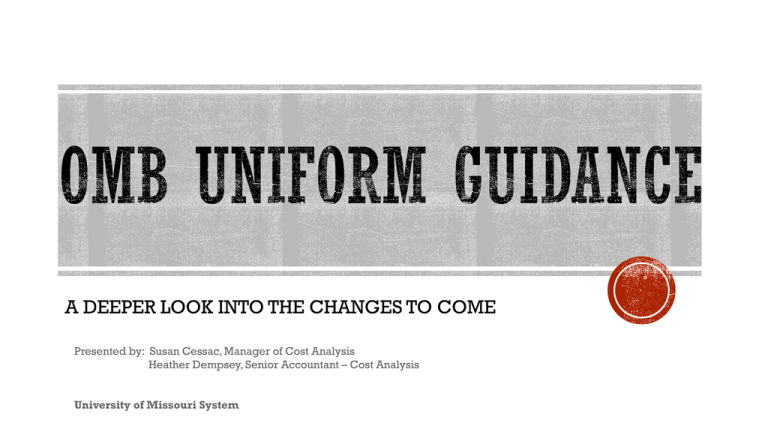
A DEEPER LOOK INTO THE CHANGES TO COME Presented by: Susan Cessac, Manager of Cost Analysis Heather Dempsey, Senior Accountant – Cost Analysis University of Missouri System A-87 A122 A-50 A102 A-89 2 CFR 200 A110 A-21 A133 Uniform Guidance (UG) is a combined, simplified, version of 8 circulars. Subpart A – Acronyms and Definitions Subpart B – General Provisions Subpart C – Pre-award Requirements & Contents of Federal Awards Subpart D – Post Federal Award Requirements Subpart E – Cost Principles Subpart F – Audit Requirements Appendices – I Funding Opportunities II Contract Provisions III Indirect Costs (F&A) §200.110 Uniform Guidance (UG) implementation date of 12/26/14 for all Subparts, except Subpart F, which will be effective the first FY beginning after 12/26/14 (so FY16) The UG will be applicable for new awards and for any incremental funding awarded on or after 12/26/14 §200.112 Requires Federal awarding agencies to establish a conflict of interest policy for Federal awards. The non-Federal entity must disclose in writing any potential conflict of interest to the Federal awarding agency or pass-through entity in accordance with applicable Federal awarding agency policy. This refers to conflicts that might arise around how a non-Federal entity expends funds under a Federal award. These types of decisions include, for example, selection of a subrecipient or procurements as described in section 200.318. Requires a disclosure to the awarding agency of potential conflicts of interest in accordance with that agency’s policy Agencies implementation plans should be reviewed for additional guidance or requirements §200.203 60 Days Lead Time Agencies must generally post opportunities at last 60 calendar days prior to due date, but …. no opportunities should be available for less than 30 calendar days §200.301 Continued pressure from agencies to relate research progress to financial information and other “data” (e.g., number of students, publications, patents) The Federal awarding agency must require the recipient to use OMB-approved governmentwide standard information collections when providing financial and performance information. The Federal awarding agency must require the recipient to relate financial data to performance accomplishments of the Federal award. Also, in accordance with above mentioned governmentwide standard information collections, and when applicable, recipients must also provide cost information to demonstrate cost effective practices (e.g., through unit cost data). Guidance provides for research sponsors to use standard Research Performance Progress Report (RPPR) format – depends on agency implementation (NSF is on board!) §200.303 Requires recipients to have internal controls in compliance with guidance in “Standards for Internal Control in the Federal Government” and “Internal Control Integrated Framework” issued by COSO COFAR clarified in the recent FAQ release that there is no expectation or requirement that internal controls be documented or evaluated prescriptively to these guidelines Provided as source documents for best practices §200.306 Voluntary committed cost sharing may not be used as a factor during the merit review of applications or proposals, but may be considered if it is both in accordance with Federal awarding agency regulations and specified in a notice of funding opportunity. Voluntary committed cost sharing is NOT expected, could be basis for exclusion (NSF) Criteria for considering voluntary committed cost sharing and any other program policy factors that may be used to determine who may receive a Federal award must be explicitly described in the notice of funding opportunity. §200.307 Income from license fees and royalties on research funded by a Federal award should be excluded from the definition of program income. US law or statute takes precedent over the Uniform Guidance. The guidance in section 200.400(g) states that the non-Federal entity may not earn or keep any profit resulting from Federal financial assistance, unless expressly authorized by the terms and conditions of the Federal award. If the Federal agency does not specify in its regulations or the terms and conditions of the Federal award how program income is to be used, the Addition method must apply. When the Federal awarding agency authorizes the Addition method or Cost sharing or matching, program income in excess of the amounts specified must also be deducted from expenditures. The default to the Addition method for IHEs and nonprofit research institutions standardizes this practice. Under A-110, standard use of the Addition method for IHEs and nonprofit research institutions is not specified as the default. §200.308 Revision of budget For non-construction Federal awards, recipients must request prior approvals from Federal awarding agencies for one or more of the following program or budget-related reasons: The disengagement from the project for more than three months, or a 25 percent reduction in time devoted to the project, by the approved project director or principal investigator New language added to reflect that project directors can be away from campus and remain engaged in the project at the proposed and awarded levels. “Disengagement” from the project for more than three months, rather than “absence” from the project (A-21). WORKING OFF-SITE §200.319 The non-Federal entity must conduct procurements in a manner that prohibits the use of statutorily or administratively imposed state or local geographical preferences in the evaluation of bids or proposals, except in those cases where applicable Federal statutes expressly mandate or encourage geographic preference. This could create conflict for public universities required to follow State Statute §200.320 A prescriptive list of 5 procurement methods are provided New category of “micro-purchase” which appears to allow purchases of up to $3,000 without competition Small purchases over $3,000 would rate quotations – at least two Concern: This could have implications on procurement card programs and bid thresholds. The current threshold on P-Cards is $5,000 COFAR issued FAQ granting a 1-year grace period to review additional options for implementation. UM would have to implement new procedures by 7/1/16 to be in compliance with this new regulation §200.331 F&A improvements Sponsors (agency and pass-through) are obligated to honor subrecipient’s negotiated F&A rate Subrecipients without a negotiated rate can get a 10% MTDC F&A rate or can negotiate a rate with the pass-through entity Increased burdens for subaward issuance Agency prior approval required before using a fixed price subaward New limit on size of fixed price subawards ($150K) (200.332) New mandatory list of data elements that have to be included in each subaward Clarification that required reports from your subrecipient, must be included in your subaward agreement. §200.330 Vendor vs. subrecipient classification Clarification that pass-through entity must make determination classification Each agency may supply and require pass-through entities to comply with additional guidance to support their classifications §200.331 Probable increase in subrecipient monitoring burdens Explicit list of mandatory and optional factors to be included in subrecipient monitoring New obligation to review financial and performance reports PI’s will be required to certify that they received and reviewed performance reports from the subrecipients. §200.343 The non-Federal entity must submit, no later than 90 calendar days after the end of the date of the period of performance, all financial, performance, and other reports as required by or the terms and conditions of the Federal award. The Federal awarding agency or pass-through entity may approve extensions when requested by the non-Federal entity. The financial reports include all final final reimbursement requests or Letter of Credit draws. Funds remaining will be deobligated after the 90 calendar days. COGR has submitted a request to NSF to extend the submission date for all financial, performance, and other reports and the liquidation date be set to a new standard of 120 days after the end date of the award. §200.407 “Under any given Federal award, the reasonableness and allocability of certain items of costs may be difficult to determine. In order to avoid subsequent disallowance or dispute based on unreasonableness or nonallocability, the nonFederal entity may seek the prior written approval of the cognizant agency for indirect costs or the Federal awarding agency in advance of the incurrence of special or unusual costs.” Do not confuse with standard prior approval requirements Identifies those “sensitive” areas where institution may not feel 100% comfortable Written approval may help justification §200.413: “The salaries of administrative and clerical staff should normally be treated as indirect (F&A) costs. Direct charging of these costs may be appropriate only if all of the following conditions are met: 1. 2. 3. 4. Administrative or clerical services are integral to a project or activity; Individuals involved can be specifically identified with the project or activity; Such costs are explicitly included in the budget or have the prior written approval of the Federal awarding agency; and The costs are not also recovered as indirect costs.” Removal of “major project” language Recognition of administrative workload Refer to individual Federal agency implementation plans for additional guidance. §200.415: “‘By signing this report, I certify to the best of my knowledge and belief that the report is true, complete, and accurate, and the expenditures, disbursements and cash receipts are for the purposes and objectives set forth in the terms and conditions of the Federal award. I am aware that any false, fictitious, or fraudulent information, or the omission of any material fact, may subject me to criminal, civil or administrative penalties for fraud, false statements, false claims or otherwise. (U.S. Code Title 18, Section 1001 and Title 31, Sections 3729–3730 and 3801–3812).’’ Extremely strong language may find opposition “…signed by an official who is authorized to legally bind the nonFederal entity“ May require signature authority/delegation at institution Important to ensure all costs are allowable and allocable to the project via periodic reviews of individual transactions. §200.430 More Flexibility Eliminated Examples of acceptable Methods for Payroll Distribution Added concept of IBS (ii) The non-Federal entity establishes a consistent written definition of work covered by IBS which is specific enough to determine conclusively when work beyond that level has occurred Allowable activities: Added language to allow for “developing and maintaining protocols”…. “managing and securing project-specific data, coordinating research subjects…” Also added (2) For records which meet the standards …not be required to provide additional support or documentation for the work performed… But stringent framework of internal controls… “Control” or “Internal Control” is mentioned 16 times in the preamble “This final guidance requires non-Federal entities to comply with a stringent framework of internal control objectives and requirements.” Reasonable Assurance that charges are accurate, allowable, & properly allocated Emphasis on written policies and “consistent definition of work covered by IBS” Continued focus on “processes to review after-the-fact” / Must reflect the work performed 200.303 Internal Controls These internal controls should be in compliance with the COSO framework which stresses management review COSO: Integrated Framework of Control Environment, Risk Assessment, Control Activities, Information and Communication, & Monitoring Activities §200.94: definition of supplies – “Supplies means all tangible personal property other than those described in § 200.33 Equipment. A computing device is a supply if the acquisition cost is less than the lesser of the capitalization level established by the non-Federal entity for financial statement purposes or $5,000, regardless of the length of its useful life.” Computing devices can include laptops, ipads, smart phones, etc. Acknowledgement of computing devices as a supply cost §200.453 Materials and Supplies (New Rule) (c) “In the specific case of computing devices, charging as direct costs is allowable for devices that are essential and allocable, but not solely dedicated, to the performance of a Federal award.” §200.456 Definition: Direct costs for items such as stipends or subsistence allowances, travel allowances, and registration fees paid to or on behalf of participants or trainees in connection with conferences or training projects. Participant is defined as an individual who is the recipient of a service or training provided at a workshop, conference, seminar, symposium or other short-term instructional or information sharing activity funded by a sponsored project. These costs must now be accepted by agencies as allowable costs, but still require prior agency approval. Must be excluded when calculating the Modified Total Direct Costs (MTDC) to determine the overall project’s F&A costs. §200.461 Anticipated publication charges are still allowable costs after award end date but before closeout (in essence, adoption of the NSF model); costs must be consistently charged as a direct cost. §200.463 Visa Costs A-21 Silent NIH considers visa costs allowable under recruiting costs Uniform Guidance Costs associated with visas when critical skills are needed for a specific award may be proposed and charged as a direct cost Short-term, travel visa costs (as opposed to longer-term, immigration visas) are generally allowable expenses that may be proposed as a direct cost. Since the short-term visas are issued for a specific period and purpose, they can be clearly identified as directly connected to work performed on a Federal award. Continuing to determine full implications and impact of UG and updating policies as needed Still waiting for agencies to weigh in OMB Uniform Guidance info on our website and campus Sponsored Programs websites: http://www.umsystem.edu/ums/fa/controller/sponsoredprograms Any Questions?
